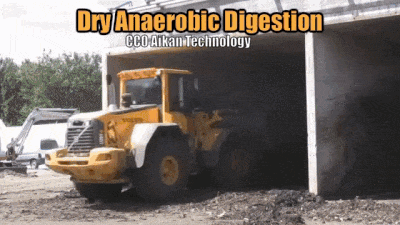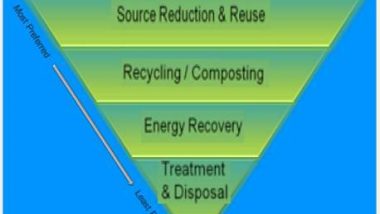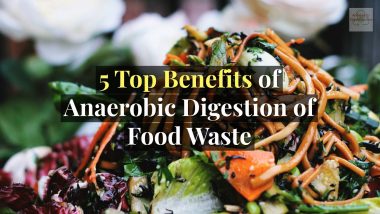Dry AD: This article is about what happens inside a Dry Anaerobic Digestion Plant. we might also have called it “The Dry Anaerobic Digestion Process Explained Stage by Stage”. In brief, if you want to know what is Dry AD, read-on!
Dry anaerobic digestion has been seen by some to be a bit of a secret. It isn't, but the impression of it being a hidden technology persists, because most people in the AD industry provide “wet AD” processes.
Why Isn't Dry Anaerobic Digestion (AD) as Well Publicised as It's Wet Counterpart?
The mainstream AD people don't mention it, because they don't offer it.
That does not detract from the legitimacy of the technology, which can only be applied for dry organic feed materials. By suitable dry AD feedstocks we mean organic materials which will stand-up in the bucket of a front-end loading machine, and will be reasonably granular, allowing a good passage of air and liquid through the bulk of the material.
You can add water to most dry AD feedstocks which would be suitable for Dry AD (see ArrowBio), and then use the tradition big tanks (CSR designs) which are most common. It would seldom, if ever, make economic sense to take a wet, substantially liquid anaerobic digestion feedstock and dry it in order to apply the Dry AD process.
Dry AD is particularly well-suited to processing the organic fraction of municipal solid waste, after a high degree of recycling has been done on “black bag” residual MSW. It is very useful as a component of a zero-waste to landfill strategy. Our view is that the technology has a very positive future, and its use will continue to expand, especially where communities move toward implementing “zero-waste”.
Now we have introduced the technology and you know what Dry AD is good for, we move to the heart of the matter, which is exactly what happens inside a typical Dry Anaerobic Digestion Plant. But, please be aware that practices do vary between the various dry AD technology providers.
The following description is available on the Waste Advantage Magazine website. (A visit to that, much longer, article is recommended for the serious reader – link provided below this section.)
What Happens Inside a Dry Anaerobic Digestion Plant – Step by Step
The SmartFerm AD facility includes the following four major digestion stage process phases leading to biogas production, as described below:
- Supply Air and Aeration—Once the organic wastes are loaded into a digester, a hatch door is closed using a gas seal to ensure that biogas cannot escape. Each digester contains an in-floor aeration system which is activated once the door is sealed. This aeration system pumps air from outside into the organic waste to help create aerobic digestion conditions that self-heat the material to designed process conditions for the first 12 hours. A mixture of oxygen and methane is potentially combustible so the chamber air is purged to remove remaining oxygen before the anaerobic cycle commences.
- Percolate Cycle—Under anaerobic conditions, the waste materials are sprayed with conditioned process water containing thermophilic microorganisms (percolate) that begin the decomposition process and produce biogas. This percolate is pumped in a closed loop between the digesters and the heated and insulated percolate tanks located beneath the digester units. Percolate continues to be sprinkled on the waste materials for approximately 20 days causing the production of biogas. Percolate is collected in a drainage system, screened for solids, and pumped back into a percolate tank where it is recharged with thermophilic organisms. Process control instrumentation ensures proper control of the percolate tank and regulation of percolate temperature.
- Biogas System—Biogas from each digester is pumped to the percolate tank to obtain a rich, homogenized biogas, then pumped to a roof-top, double-membrane storage bladder. The stored biogas is then combusted in a power plant or compressed into natural gas (CNG) for future uses.
- Exhaust Air—On the 21st day of processing (and before the digester doors are opened) ambient air within the digester is collected in an exhaust piping system. Low quality biogas (less than 20 percent methane) is combusted and the digester air is transferred to a biofilter for treatment. via SmartFermArticle
This is very similar to in-vessel composting, but in composting there is no anaerobic stage, and therefore no possibility to extract biogas energy.
For the case study described, we are also informed of the following:
- Following digestion, the residual is moved to another chamber where the material is partially composted using forced air.
- After approximately four days this material is removed and put into outside windrows to complete the composting process.
- Odors are minimized because the entire facility is enclosed and process air is circulated through a biofilter.
- The digestate emerging at the end of the process is free of pathogens (per U.S. EPA’s Process to Further Reduce Pathogen’s requirements). via SmartFermArticle
The above isn't the whole step by step story, and we are indebted to another website for that information, as follows (link to that website is provided after this section):
What happens inside an AD plant Before the Dry AD process?
- The food waste delivered to the facility is weighed at the weighbridge.
- The fully enclosed pre-treatment building has measures in place to control noise, dust and odour. Once inside, lorries tip their load into a designated tipping area. All received material is inspected and any unsuitable items (contaminants, such as metals or plastic) are removed.
- Following pre-treatment (recycling/ shredding), the organic matter is fed into the digestion process. From this point forward, it is entirely contained within sealed pipework, tanks and specially designed and built sealed so-called “tunnels”. via TamarEnergy
What happens inside an AD plant After the Dry AD process?
- Biogas produced from the digestion process is extracted from the top of each digester and taken to a Combined Heat and Power (CHP) unit, where it is used to generate renewable energy. This process generates heat, which is captured for use on site for space heating or in neighboring buildings. The electricity generated provides all the on-site power required for the plant, with the majority sent to the local electricity network.
- At the end of the process, a stable, nutrient-rich biofertilizer is created. The process meets stringent requirements set by the regulatory bodies in charge. In the UK the standard applied is often the British Standards Institute “PAS110 Guidance' and, the Environment Agency and ABPR (Government regulations for animal by products). via TamarEnergy
More Hints for Successful Dry Anaerobic Digestion
1. Carbon to Nitrogen Ratio
All AD plant operators will tell you that feedstocks are mixed before they are loaded into the digester tunnels for an optimized Carbon to Nitrogen Ratio, prior to digestion. It is essential to get this first step right for successful anaerobic digestion. Apparently, the feedstock shovel loading operator is trained to mix the feedstock as it is loaded and the AD tunnel filled. The general rule is that, brown or woody material has a high ratio and green material or food waste has a low ratio.
2. How Feedstock Material is Stored on Arrival Without Causing Nuisance Odors for Neighbors
Material which is delivered for digestion must be stored awaiting an available digester chamber. The way to do this is in a bay which is in a building under negative pressure (i.e., a vacuum) for odor control.
2. How Long Should the Fermentation Stage Run for?
We have seen guidance that a 21 day, 3-phase process begins should take place for an adequate period after the mixed feedstock is added to a digestion chamber.
Start: Anaerobic digestion only occurs in a specific temperature range. To bring material into this range, a heat-generating, aerobic decomposition process is started by pumping air into the chamber allowing the material to heat itself up naturally! It’s a clever solution with lower energy requirements than heating up the material with steam or hot air.
Fermentation: Once at the correct temperature, percolate with bacteria from cows’ digestive tracts is sprayed onto the material, starting digestion and producing biogas. The key indicators during fermentation is quality and quantity of methane produced. Unfortunately, high quality doesn’t occur during times of high quantity. To increase quality, CO2 and other components are filtered out.
Termination: After ~20 days, methane production has been greatly reduced and doesn’t make sense to continue. To stop the process, percolate is no longer sprayed onto the material. Air is again added to the chamber but this time to purge the chamber of methane and create a safe/non-explosive environment to open the chamber and allow the removal of digestate.
Remaining digestate is treated in an IVC (In-Vessel Composting) tunnel to compost the material. The tunnel also removes ammonia gas produced and processes it with an acid scrubber where sulfuric acid is sprayed over the gas to precipitate out the ammonia as ammonium sulfate.
Scrubbed gas then passes through a BioFilter similar to the flora on a forest floor – removing odors and harmful gases – and into the atmosphere. The compost produced is screened offsite and sold to farms!
Overall, the facility is a great example of anaerobic digestion with space and odor constraints while remaining financially viable.
There is a great YouTube video summarizing the process. via the South San Francisco Scavenger article.
If you found this page useful you might also want to visit our other Dry Anaerobic Digestion article here.





Dry AD. Who are you kidding! It probably just means you can’t booze when on site. 🙂 No way. I’d rather visit a brewery any day! Nice site. Nice post. Thanks.
I see you are making the best to make people interested in a dry subject. My point is that Dry AD is able to process a greater proportion of the biowaste stream, making it suitable for green waste, food waste, and even the organic fraction separated from municipal ‘black bag’ waste. OK, it’s not all good news, but it could be made use of much more.
Could you please tell what is the process time usually applied per batch for a given biomass type.
A fermentation stage process time of 21 days is given in one example in this article. it is not clear though what the feedstock was exactly.
I’m still learning from you. I definitely enjoy reading all that is posted on your website. Keep the info coming. But, isn’t this a dry subject? lol!
I just added your blog to my Bookmarks. One important question though, besides the sale of the final compost, how does this kind of business finance its operations? Many thanks.
I assume that all these plants will be gaining their main income from electricity generation fed into their local power grid. They may also be charging a gate fee for acceptance of their green waste, municipal waste, food waste etc.
HI,
I just found your website. Can chicken litter with 75% DM be used as a feedstock. I am aware of the high nitrogen content buy this can be reduced by adding straw pellets at a ratio of 50/50. It is possible to bed the chickens in the straw first. Due to EU nitrates regulations the digestate must then be further dried and pelletised and sold as a biofertilizer. But my question is whether or not chicken litter has been used as a feedstock for the dry AD process. Thank you – Seamus Gallagher, Ireland
Dry Anaerobic Digestion of municipal Solid Waste is reasonably well-established as practiced by a number of AD companies, but as it is used as a pretreatment proir to landfilling all they have to achieve is the required reduction in organic activity stipulated by the regulations for landfill pretreatment. These are nowhere near as onerous as the digestate quality needed to produce a fertiliser product.
In my travels I have not seen a dry AD plant on a farm which uses chicken litter as a substantial proportion of the feedstock which uses dry AD. The ones I’ve visited use wet anaerobic digestion in a CSTR and I believe that they co-digest the chicken litter with other farm feedstocks such as maize (whole plant) and grass.
I Googled “dry anaerobic digestion of chicken litter”. And, I found that the first half dozen sites listed are research papers, such as: https://www.mdpi.com/2076-3417/10/21/7825 which concludes that even with co-fermentation with lower nitrogen feed materials dry anaerobic digestion is unstable.
That conclusion seems to be confirmed by Craig Coker of Biocycle https://www.biocycle.net/poultry-litter-digestion/
Finally, regarding pelletising, you would end-up with both liquid and solid/fibrous digestate, and if not disposing either of those to land, wouldn’t you need to sell both as a fertiliser product and I think that you would need to experiment first to see whether your output would be readily pelletisable using the available equipment. Also, I think that you would need to discuss with the EPA whether the fertiliser would remain a waste, or be deemed a “product”.
Hi,
Yes, the digestate would be seperated, the liquid treated with reverse osmosis and used again on the farm. There is also a market for liquid fertiliser, especially in times of very dry weather for direct application. The solid material would then be dried further and pelletised for sale in 500kg bags as an organic fertiliser, which currently is very costly by the way. So with all this mind the major issue to hand is the pre-treatment opf the feedstock in order optimise the methane production. In my experience 1 ton of chicken litter has the same methane potential as 1 tonne of grass silage but has 3 times the nitrogen content, therefore a balancer must be added to reduce the nitrogen of the overall mix. Nitrogen stripping by means of acid treatment is also very expensive
You clearly do have a winning process both for your farm and many others.
If you can make this work it would in my opinion be a big step forward for not only your business and sustainable agriculture but many others confronted by the need to comply with EU nitrates regulations.
I am sure that many of our visitors would be interested if you would come back again and update us on progress.